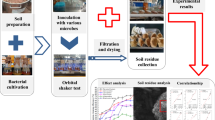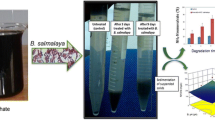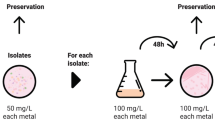Abstract
Environmental purification using microorganisms has drawn attention for the decontamination of 137Cs released during a nuclear accident; however, Cs absorption by microorganisms is inhibited by the coexistence of potassium. In this study, we aimed to identify Cs-absorbing bacteria resistant to the inhibition of Cs absorption in the coexistence of potassium for the purpose of decontaminating 137Cs-contaminated biomass. When anaerobic sludge was cultured with the addition of CsCl, Cs accumulated in the microorganisms. This may be because Cs administration promoted the growth of specific Cs-absorbing bacteria. Metagenomics analysis of flora showed that the Tepidibacter genus dominated in the presence of Cs. In addition, Tepidibacter mesophilus accumulated 61.8 kBq/g dry weight of 137Cs in the presence of 4 mM K+, and presented high 137Cs-absorption ability, even in the presence of K+. Moreover, 74% of 137Cs absorption by anaerobic sludge was estimated to be due to bacteria of the Tepidibacter genus. It is assumed that 137Cs in the surface soil layer can be absorbed by surrounding microorganisms along with microbial decomposition of biomass containing a large amount of K+. Therefore, anaerobic sludge containing Tepidibacter genus may be used in the decontamination process of Cs released into environment as a useful Cs-accumulating flora.







Similar content being viewed by others
References
Yasunari TJ, Stohl A, Hayano RS, Burkhart JF, Eckhardt S, Yasunari T (2011) Cesium-137 deposition and contamination of Japanese soils due to the Fukushima nuclear accident. Proc Natl Acad Sci USA 108:19530–19534
Watanabe T, Tsuchiya N, Oura Y, Ebihara M, Inoue C, Hirano N, Yamada R, Yamasaki S, Okamoto A, Nara FW, Nunohara K (2012) Distribution of artificial radionuclides (110mAg, 129mTe, 134Cs, 137Cs) in surface soil from Miyagi Prefecture, northeast Japan, following the 2011 Fukushima Dai-ichi nuclear power plant accident. Geochem J 46:279–285
Fuller AJ, Shaw S, Ward MB, Haigh SJ, Mosselmans JFW, Peacock CL, Stachouse S, Dent AJ, Trivedi D, Burke IT (2015) Caesium incorporation and retention in illite interlayers. Appl Clay Sci 108:128–134
Nikolaevsky VB, Lifanov FA, Batusov SS (2013) Improving the decontamination of 137Cs contaminated soil. At Energy 114:51–55
Kimabara K, Hirai H, Otsuka Y, Nakamura M, Sasaki K, Nakashimada Y, Kato J (2013) Devepolment of a total treatment system for volume reduction of biomass which contaminated by radioactive materials. J Environ Biotechnol 13:31–38
Sasaki K, Morikawa H, Kishibe T, Mikami A, Harada T, Ohta M (2012) Practical removal of radioactivity from sediment mud in a swimming pool in Fukushima, Japan by immobilized photosynthetic bacteria. Biosci Biotechnol Biochem 76:859–862
Sasaki H, Shirato S, Tahara T, Sato K, Takenaka H (2013) Accumulation of radioactive cesium released from Fukushima Daiichi Nuclear Power Plant in Terrestrial Cyanobacteria Nostoc commune. Microbes Environ 28:466–469
Tomioka N, Tanaka K, Uchiyama H, Yagi O, Kokufuta E (1998) Recovery of 137Cs by a bioaccumulation system using Rhodococcus erythropolis CS98. J Ferment Bioeng 85:604–608
Sasaki K, Nakamura K, Takeno K, Shinkawa H, Das N, Sasaki K (2015) Removal of radioactivity from sediment mud and soil and use for cultivation of safe vegetables in Fukushima, and removal of toxic metals using photosynthetic bacteria. J Agric Chem Environ 4:63–75
Sasaki K, Morikawa H, Kishibe T, Takeno K, Mikami A, Harada T, Ohta M (2013) Simultaneous removal of cesium and strontium using a photosynthetic bacterium, Rhodobacter sphaeroides SSI immobilized on porous ceramic made from waste glass. Adv Biosci Biotechnol 4:6–13
Tomioka N, Uchiyama H, Yagi O (1992) Isolation and characterization of cesium-accumulating bacteria. Appl Environ Microbiol 58:1019–1023
Yoshida H, Tokumoto H, Ishii K, Ishii R (2009) Efficient, high-speed methane fermentation for sewage sludge using subcritical water hydrolysis as pretreatment. Bioresour Technol 100:2933–2939
Tokumoto H, Kashiwagi M (2012) Changes in dominant fermentation type during anaerobic digestion of high-loading glycerol with slight glucose content. Bioresour Technol 126:13–17
Jiang H, Dong H, Zhang G, Yu B, Chapman LR, Fields MW (2006) Microbial diversity in water and sediment of Lake Chaka, an athalassohaline lake in northwestern China. Appl Environ Microbiol 72:3832–3845
Muyzer G, de Waal EC, Uitterlinden AG (1993) Profiling of complex microbial populations by denaturing gradient gel electrophoresis analysis of polymerase chain reaction-amplified genes coding for 16S rRNA. Appl Environ Microbiol 59:695–700
Klindworth A, Pruesse E, Schweer T, Peplle J, Quast C, Horn M, Glöckner FO (2013) Evaluation of general 16S ribosomal RNA gene PCR primer for classical and next-generation sequencing-based diversity studies. Nucleic Acids Res 41:e1
Caporaso JG, Kuczynski J, Stombaugh J, Bittinger K, Bushman FD, Costello EK, Fierer N, Pena AG, Goodrich JK, Gordon JI, Huttley GA, Kelley ST, Knirhts D, Koenig JE, Ley RE, Lozupone CA, Mcdonald D, Muegge BD, Pirrung M, Reeder J, Sevinsky JR, Turnbaugh PJ, Walters WA, Widmann J, Yatsunenko T, Zaneveld J, Knight R (2010) QIIME allows analysis of high-throughput community sequencing data. Nat Methods 7:335–336
Batstone DJ, Keller J, Angelidaki I, Kalyuzhnyi SV, Pavlostathis SG, Rozzi A, Sanders WTM, Siegrist H, Vavilin VA (2002) The IWA anaerobic digestion model no. 1 (ADM1). Wat Sci Technol 45:65–73
Lerm S, Kleybocker A, Miethling-Graff R, Alawi M, Kasina M, Liebrich M, Wurdemann H (2012) Archaeal community composition affects the function of anaerobic co-digesters in response to organic overload. Waste Manag 32:389–399
Ogg CD, Patel BKC (2009) Caloramator australicus sp. nov., a themophilic, anaerobic bacterium from the Great Artesian Basin of Australia. Int J Syst Evol Microbiol 59:95–101
Ogg CD, Patel BKC (2011) Caloramator mitchellensis sp. nov., a thermoanaerobe isolated from the geothermal waters of the Great Artesian Basin of Australia, and emended description of the genus Caloramator. Int J Syst Evol Microbiol 61:644–653
Tan HQ, Wu XY, Zhang XQ, Wu M, Zhu XF (2012) Tepidibacter mesophilus sp. nov., a mesophilic fermentative anaerobe isolated from soil polluted by crude oil, and emended description of the genus Tepidibacter. Int J Syst Evol Microbiol 62:66–70
Tomioka N, Uchiyama H, Yagi O (1994) Cesium accumulation and growth characteristics of Rhodococcus erythropolis CS98 and Rhodococcus sp. strain CS402. Appl Environ Microbiol 60:2227–2231
Lan T, Feng Y, Liao J, Li X, Ding C, Zhang D, Yang J, Zeng J, Yang Y, Tang J, Liu N (2014) Biosorption behavior and mechanism of cesium-137 on Rhodosporidium fluviale strain UA2 isolated from cesium solution. J Environ Radioact 134:6–13
Acknowledgements
The authors would like to thank Dr. A. Nakabachi and Dr. Y. Hirose, Toyohashi University of Technology, for the assistance with the NGS analysis. This work was supported by JSPS KAKENHI Grant Number JP16H02982 from the Japan Society for the Promotion Science and a research grant from the Kansai Atomic Conference. The sponsors had no role in the study design; in the collection, analysis, and interpretation of data; in the writing of the report; and in the decision to submit the article for publication. All procedures performed in this study comply with the current law of the country in which they were performed.
Author information
Authors and Affiliations
Corresponding author
Additional information
Publisher's Note
Springer Nature remains neutral with regard to jurisdictional claims in published maps and institutional affiliations.
Rights and permissions
About this article
Cite this article
Tokumoto, H., Nomoto, K. & Kurahashi, K. Identification of novel bacteria capable of accumulating 137Cs under K+ from anaerobic digested sludge for decontamination of 137Cs-contaminated biomass. J Mater Cycles Waste Manag 22, 1103–1112 (2020). https://doi.org/10.1007/s10163-020-01004-7
Received:
Accepted:
Published:
Issue Date:
DOI: https://doi.org/10.1007/s10163-020-01004-7




